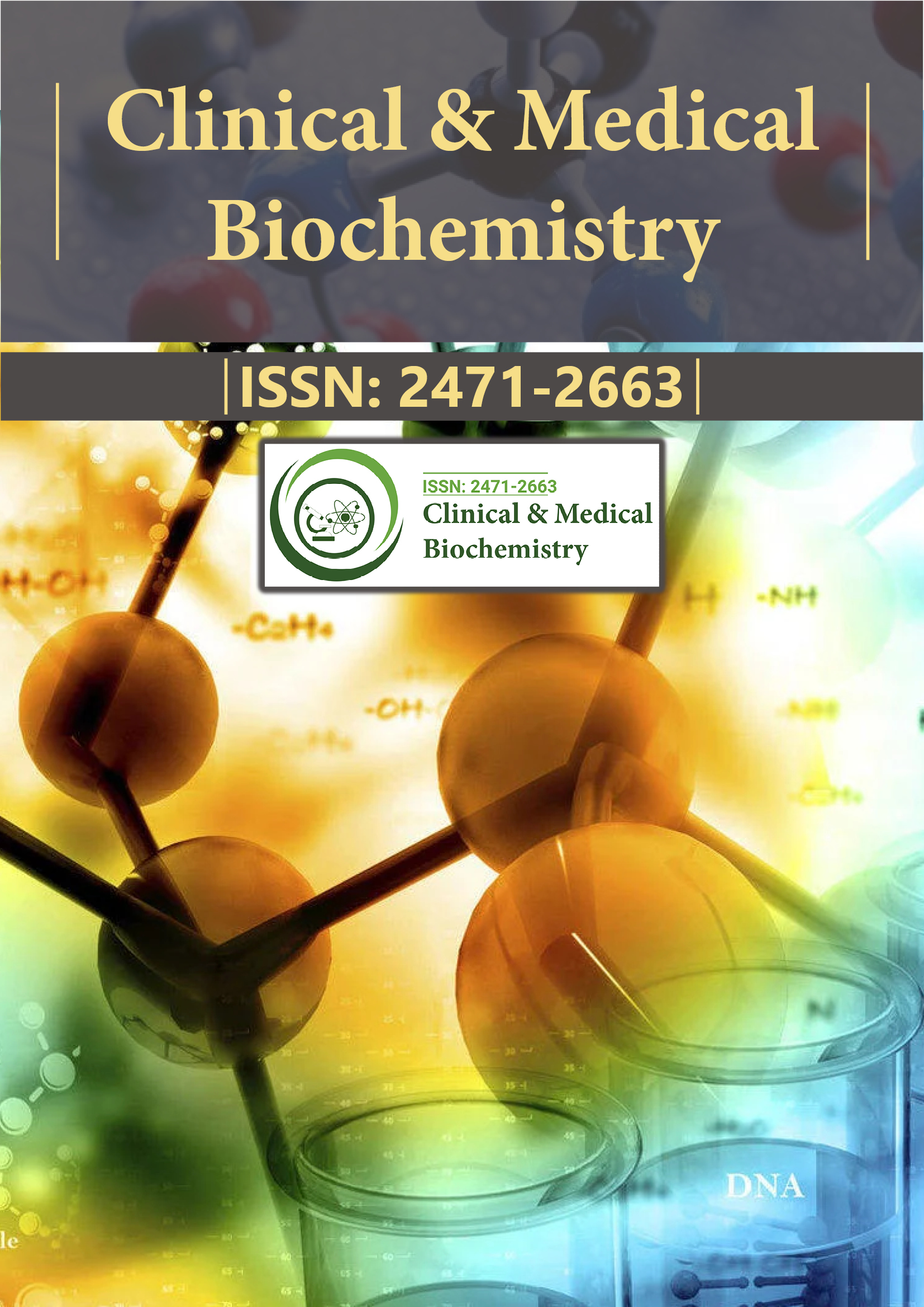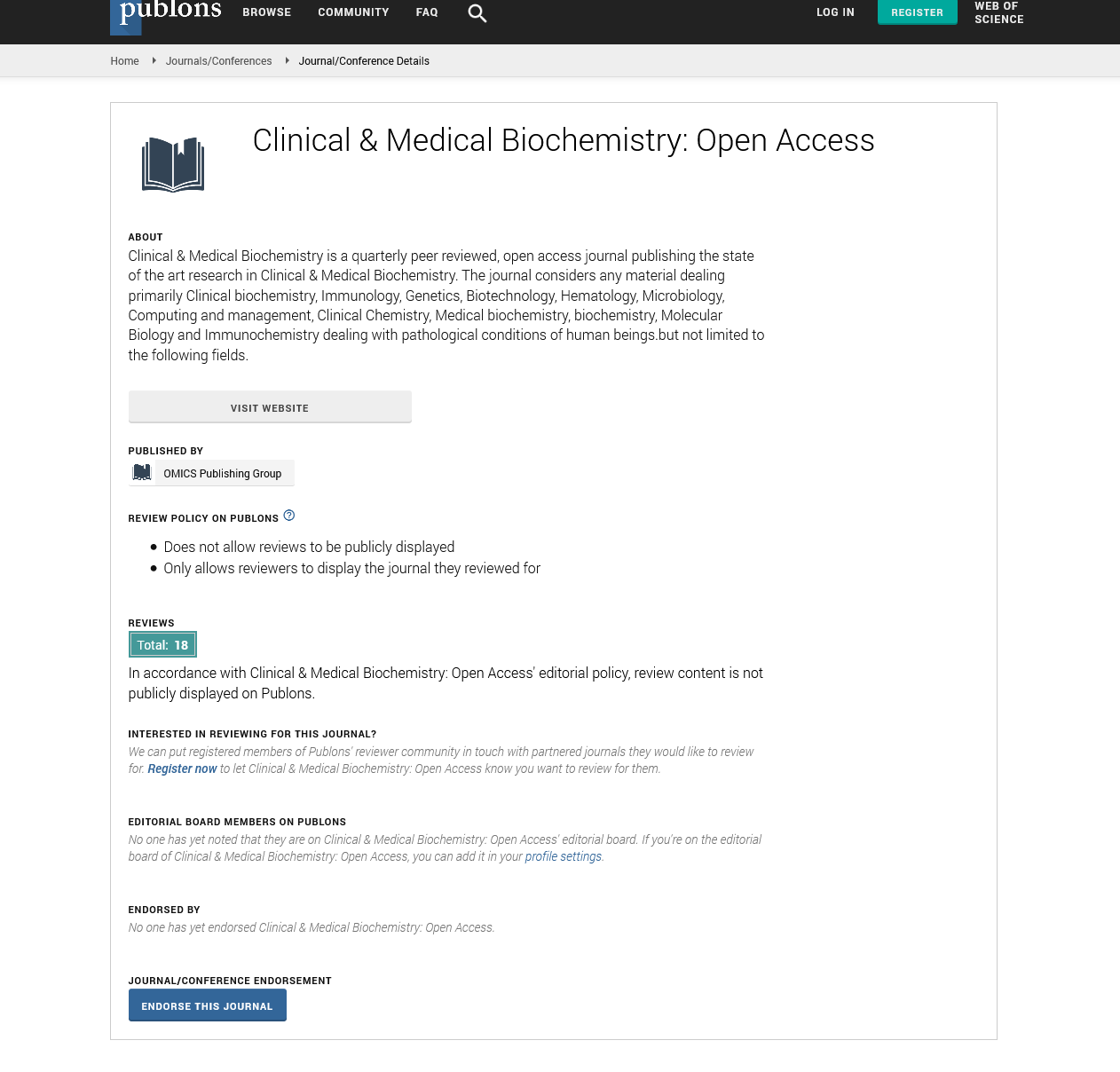Indexed In
- RefSeek
- Directory of Research Journal Indexing (DRJI)
- Hamdard University
- EBSCO A-Z
- OCLC- WorldCat
- Scholarsteer
- Publons
- Euro Pub
- Google Scholar
Useful Links
Share This Page
Journal Flyer

Open Access Journals
- Agri and Aquaculture
- Biochemistry
- Bioinformatics & Systems Biology
- Business & Management
- Chemistry
- Clinical Sciences
- Engineering
- Food & Nutrition
- General Science
- Genetics & Molecular Biology
- Immunology & Microbiology
- Medical Sciences
- Neuroscience & Psychology
- Nursing & Health Care
- Pharmaceutical Sciences
Short Communication - (2024) Volume 10, Issue 4
Biochemical Mechanisms of Aging: Targeting Cellular Dysfunction to Promote Healthy Aging
Sarah Grace*Received: 25-Nov-2024, Manuscript No. CMBO-24-28345; Editor assigned: 27-Nov-2024, Pre QC No. CMBO-24-28345 (PQ); Reviewed: 12-Dec-2024, QC No. CMBO-24-28345; Revised: 20-Dec-2024, Manuscript No. CMBO-24-28345 (R); Published: 27-Dec-2024, DOI: 10.35841/2471-2663.24.10.232
Description
Aging is a complex biological process that involves a gradual decline in cellular function, leading to the deterioration of tissues and organs over time. The biochemistry of aging refers to the molecular and cellular changes that occur within the body as people age. These changes are influenced by genetic, environmental and lifestyle factors and contribute to the aging process in various ways. Several biochemical mechanisms have been identified as key factors in aging, including oxidative stress, cellular senescence, mitochondrial dysfunction and changes in protein homeostasis. Understanding these processes is important for developing strategies to reduce aging-related diseases and improve health during the aging process [1-3].
One of the most well-studied biochemical mechanisms of aging is oxidative stress. Free radicals, particularly Reactive Oxygen Species (ROS), are highly reactive molecules that can cause damage to cellular components, including proteins, lipids and DNA. ROS are generated as by-products of normal cellular metabolism, particularly in the mitochondria during ATP production. Over time, the accumulation of oxidative damage contributes to the aging process and the development of age related diseases such as cardiovascular disease, neurodegenerative disorders and cancer. Antioxidant defense systems, such as superoxide dismutase, catalase and glutathione peroxidase, normally neutralize ROS and prevent excessive damage. However, with age, the efficiency of these antioxidant systems declines, leading to an increased burden of oxidative damage [4].
Cellular senescence is another key biochemical feature of aging. Senescent cells are damaged cells that have lost their ability to divide but do not undergo programmed cell death (apoptosis). Instead, they accumulate in tissues and release a variety of pro inflammatory factors, known as the Senescence-Associated Secretory Phenotype (SASP). The accumulation of senescent cells contributes to chronic inflammation, tissue dysfunction and the development of age-related diseases such as osteoarthritis, Alzheimer's disease and atherosclerosis. Senescence can be triggered by various factors, including oxidative stress, telomere shortening and DNA damage. Telomeres are protective caps at the ends of chromosomes that shorten with each cell division. When telomeres become critically short, cells enter a state of senescence, which is believed to be a protective mechanism against cancer but also contributes to aging.
Mitochondrial dysfunction is another major biochemical driver of aging. Mitochondria are the powerhouses of the cell, responsible for producing the energy necessary for cellular functions. However, mitochondrial function declines with age and this decline is thought to play an important role in the aging process [5-7]. Aging leads to a decrease in mitochondrial number and function, as well as an increase in mitochondrial DNA mutations. These mutations can result in impaired energy production, increased oxidative stress and the accumulation of damaged proteins. The decline in mitochondrial function has been implicated in various age-related diseases, including neurodegenerative diseases like Parkinson’s and Alzheimer’s [8-10].
In conclusion, the biochemistry of aging is a multifaceted process involving oxidative stress, cellular senescence, mitochondrial dysfunction, protein homeostasis and epigenetic changes. While these processes are all interrelated, their accumulation over time leads to the gradual decline in cellular function and the development of age-related diseases. Understanding these biochemical mechanisms is important for developing strategies to extend healthy lifespan and delay the onset of age-related conditions. Research into aging continues to uncover new insights into the molecular underpinnings of the aging process, development of therapies that could slow or even reverse certain aspects of aging.
References
- Yin D, Chen K. The essential mechanisms of aging: Irreparable damage accumulation of biochemical side-reactions. Exp Gerontol. 2005;40(6):455-465.
[Crossref] [Google Scholar] [PubMed]
- Stadtman ER. Biochemical markers of aging. Exp Gerontol. 1988;23(4-5):327-347.
- Sahabi S, Jafari-Gharabaghlou D, Zarghami N. A new insight into cell biological and biochemical changes through aging. Acta Histochem. 2022;124(1):151841.
[Crossref] [Google Scholar] [PubMed]
- Clarke S. Aging as war between chemical and biochemical processes: protein methylation and the recognition of age-damaged proteins for repair. Ageing Res Rev. 2003;2(3):263-285.
[Crossref] [Google Scholar] [PubMed]
- Lane RK, Hilsabeck T, Rea SL. The role of mitochondrial dysfunction in age-related diseases. Biochim Biophys Acta. 2015;1847(11):1387-400.
[Crossref] [Google Scholar] [PubMed]
- Amorim JA, Coppotelli G, Rolo AP, Palmeira CM, Ross JM, Sinclair DA. Mitochondrial and metabolic dysfunction in ageing and age-related diseases. Nat Rev Endocrinol. 2022;18(4):243-258.
[Crossref] [Google Scholar] [PubMed]
- Miwa S, Kashyap S, Chini E, von Zglinicki T. Mitochondrial dysfunction in cell senescence and aging. J Clin Invest. 2022;132(13).
[Crossref] [Google Scholar] [PubMed]
- Dugger BN, Dickson DW. Pathology of neurodegenerative diseases. Cold Spring Harb Perspect Biol. 2017;9(7):a028035.
- Shi Y, Ma P. Pharmacological effects of Astragalus polysaccharides in treating neurodegenerative diseases. Front Pharmacol. 2024;15:1449101.
[Crossref] [Google Scholar] [PubMed]
- Hansson O. Biomarkers for neurodegenerative diseases. Nat Med. 2021;27(6):954-963.
Citation: Grace S (2024). Biochemical Mechanisms of Aging: Targeting Cellular Dysfunction to Promote Healthy Aging. Clin Med Bio Chem.10:232.
Copyright: © 2024 Grace S. This is an open-access article distributed under the terms of the Creative Commons Attribution License, which permits unrestricted use, distribution, and reproduction in any medium, provided the original author and source are credited.

